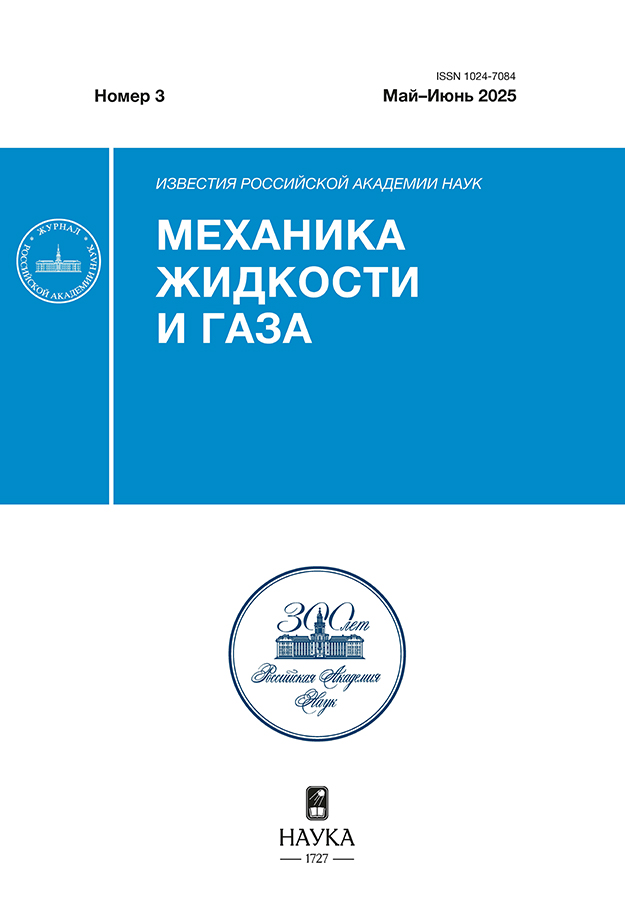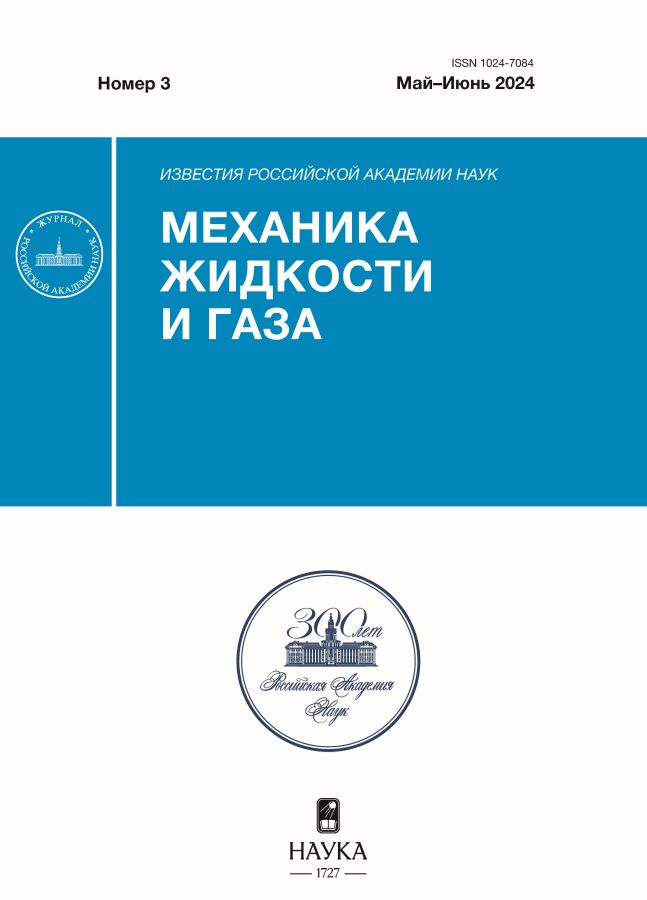Three-Dimensional Continuum Model of Lumen Formation in a Cluster of Cells Immersed in an Extracellular Matrix: The Role of Mechanical Factors
- Authors: Logvenkov S.A.1,2
-
Affiliations:
- National Research University “Higher School of Economics”
- Moscow State University
- Issue: No 3 (2024)
- Pages: 3-19
- Section: Articles
- URL: https://ruspoj.com/1024-7084/article/view/682508
- DOI: https://doi.org/10.31857/S1024708424030012
- EDN: https://elibrary.ru/PGHAUN
- ID: 682508
Cite item
Abstract
The extent of participation of mechanisms such as the active interactions of cells with each other and with the extracellular matrix, the increased hydrostatic pressure in intercellular fluid, and enzymatic activity of cells that lead to the destruction of the extracellular matrix in the process of formation of cavities in clusters of cells formed during cluster vasculogenesis is studied. The problem of evolution of a single cluster of cells immersed in a deformable extracellular matrix is solved within the framework of a previously developed continuum multiphase model of the medium formed by two actively interacting solid phases and a fluid and the role of various cellular mechanisms discussed in the formation of hollow structures is studied. The calculations showed that the dominance of active interactions of the cell-matrix type over the intercellular interactions leads to a displacement of cells towards the outer boundary of the cluster and the creation of conditions for the formation of a cavity inside the cluster. The enzymatic activity of cells helps to free up a headroom for compaction of the cluster, due to the active intercellular interactions, and to slow down the formation of the increasing concentration profile of the cellular phase. An increase in the fluid pressure in the area occupied by cells leads to acceleration of the redistribution of concentrations of the cellular phase and matrix. The fluid pressure promotes accumulation of the cellular phase near the cluster boundary and increase in the matrix concentration in its central part. And only the joint participation of all the mechanisms considered leads to the formation of a structure in which a layer formed by the cellular phase surrounds a fluid-occupied cavity, while the matrix concentration in the cavity demonstrates the trend to its complete disappearance.
Keywords
Full Text
About the authors
S. A. Logvenkov
National Research University “Higher School of Economics”; Moscow State University
Author for correspondence.
Email: logv@bk.ru
Institute of Mechanics
Russian Federation, Moscow; MoscowReferences
- Sutherland A., Keller R., Lesko A. Convergent extension in mammalian morphogenesis // Sem. Cell Dev. Biol. 2020. V. 100. P. 199–211.
- Janiszewska M., Primi M.C., Izard T. Cell adhesion in cancer: Beyond the migration of single cells // J. Biol. Chem. 2020. V. 295. № 8. P. 2495–2505.
- Tracqui P. Biophysical models of tumour growth // Rep. Progr. Phys. 2009. V. 72. № 5. P. 056701.
- Mammoto T., Ingber D.E. Mechanical control of tissue and organ development // Development. 2010. V. 137. № 9. P. 1407–1420.
- Friedl P., Gilmour D. Collective cell migration in morphogenesis, regeneration and cancer// Nat. Rev. Mol. Cell Biol. 2009. V. 10. P. 445–457.
- Blatchley M.R., Hall F., Wang S., Pruitt H.C., Gerecht S. Hypoxia and matrix viscoelasticity sequentially regulate endothelial progenitor cluster-based vasculogenesis // Sci Adv. 2019. V. 5. № 3. P. eaau7518.
- Wang S., Sekiguchi R., Daley W.P., Yamada K.M. Patterned cell and matrix dynamics in branching morphogenesis // J. Cell Biol. 2017. V. 216. № 3. P. 559–570.
- Davis G.E., Senger D.R. Endothelial extracellular matrix: biosynthesis, remodeling, and functions during vascular morphogenesis and neovessel stabilization // Circulat. Res. 2005. V. 97. № 11. P. 1093–1107.
- Poole T.J., Coffin D. Vasculogenesis and angiogenesis: Two distinct morphogenetic mechanisms establish embryonic vascular pattern // J. Exp. Zool. 1989. V. 251. № 2. P. 224–231
- Serini G., Ambrosi D., Giraudo E., Gamba A., Preziosi L., Bussolino F. Modeling the early stages of vascular network assembly // EMBO J. 2003. V. 22. № 8. P. 1771–1779.
- Ambrosi D., Gamba A., Serini G. Cell Directional and chemotaxis in vascular morphogenesis // Bull. Math. Biol. 2004. V. 66. № 6. P. 1851–1873.
- Ambrosi D., Bussolino F., Preziosi, L. A review of vasculogenesis models // J. Theor. Med. 2005. V. 6. № 1. P. 1–19.
- Kowalczyk R., Gamba A., Preziosi L. On the stability of homogeneous solutions to some aggregation models // Discrete Contin. Dyn. Syst. B. 2004. V. 4. № 1. P. 203–220.
- Scianna M., Bell C.G., Preziosi L. A review of mathematical models for the formation of vascular networks // J. Theor. Biol. 2013. V. 333. P. 174–209.
- Manoussaki D. A mechanochemical model of angiogenesis and vasculogenesis // Math. Model. Num. Anal. 2003. V. 37. № 4. P. 581–599.
- Namy P., Ohayon J., Traqui P. Critical conditions for pattern formation and in vitro tubulogenesis driven by cellular traction fields // J. Theor. Biol. 2004. V. 227. P. 103–120.
- Murray J.D., Oster G.F. Cell traction models for generating pattern and form in morphogenesis // J. Math. Biol. 1984. V. 19. P. 265–279.
- Murray J.D., Maini P.K., Tranquillo R.T. Mechanochemical models for generating biological pattern and form in development // Phys. Rep. 1988. V. 171, № 2. P. 59–84.
- Tosin A., Ambrosi D., Preziosi, L. Mechanics and Chemotaxis in the Morphogenesis of Vascular Networks // Bull. Math. Biol. 2006. V. 68. P. 1819–1836.
- Camacho-Gomez D., Garcia-Aznar J.M., Gomez-Benito M.J. A 3D multi-agent-based model for lumen morphogenesis: the role of the biophysical properties of the extracellular matrix // Eng. Comput. 2022. V. 38. P. 4135–4149.
- Fuji K., Tanida S., Sano M., Nonomura M., Riveline D., Honda H., Hiraiwa T. Computational approaches for simulating luminogenesis // Sem. Cell Dev. Biol. 2022. V. 131. P. 173–185.
- Villa C., Gerisch A., Chaplain M.A.J. A novel nonlocal partial differential equation model of endothelial progenitor cell cluster formation during the early stages of vasculogenesis // J Theor Biol. 2022. V. 534. P. 110963.
- Логвенков С.А. Математическая модель биологической среды с учетом активных взаимодействий и взаимных перемещений составляющих ее клеток // Изв. РАН. МЖГ. 2018. № 5. С. 3–16.
- Логвенков С.А., Юдина Е.Н. Исследование развития полости в клеточном сфероиде в зависимости от механизмов активных межклеточных взаимодействий // Изв. РАН. МЖГ. 2021. № 2. С. 3–14.
- Логвенков С.А., Штейн А.А. Континуальное моделирование биологической среды, составленной активно взаимодействующими клетками двух разных типов // Изв. РАН. МЖГ. 2020. № 6. С. 3–16.
- Lecuit T., Lenne P.F., Munro E. Force generation, transmission, and integration during cell and tissue morphogenesis // Ann. Rev. Cell Dev. Biol. 2011. V. 27. P. 157–184.
- Логвенков С.А. Математическое моделирование влияния клеточной подвижности и межклеточных активных взаимодействий на сортировку двух типов клеток в культурах биологических тканей // Изв. РАН. МЖГ. 2023. № 2. С. 9–19.
- Stein A.A., Logvenkov S.A., Volodyaev I.V. Continuum modeling of mechano-dependent reactions in tissues composed of mechanically active cells // BioSystems. 2018. V. 173. P. 225–234.
- Белоусов Л.В., Логвенков С.А., Штейн А.А. Математическая модель активной биологической сплошной среды с учетом деформаций и переупаковки клеток // Изв. РАН. МЖГ. 2015. № 1. С. 3–14.
- Логвенков С.А., Штейн А.А. Континуальное моделирование сортировки клеток в плоском слое с учетом возможного расхождения границ областей, занятых клетками двух разных типов // Изв. РАН. МЖГ. 2022. № 3. С. 1–14.
- Forgacs G., Foty R.A., Shafrir Y., Steinberg M.S. Viscoelastic properties of living embryonic tissues: a quantitative study // Biophys. J. 1998. V. 74. P. 2227–2234.
- Jakab K, Damon B, Marga F, Doaga O, Mironov V, Kosztin I, Markwald R, Forgacs G. Relating cell and tissue mechanics: implications and applications // Dev. Dyn. 2008. V. 237. № 9. P. 2438–2449.
- Stirbat T.V., Mgharbel A., Bodennec S. et al. Fine tuning of tissues viscosity and surface tension through contractility suggests a new role for a-catenin // PLoS One. 2013. V. 8. № 2. e52554.
- Gordon R., Goel N.S., Steinberg M.S., Wiseman L.L. Arheological mechanism sufficient to explain the kinetics of cell sorting // J. Theor. Biol. 1972. V. 37. P. 43–73.
- Lubkin S.R., Jackson T. Multiphase Mechanics of Capsule Formation in Tumors // J. Biomech. Eng. 2002. V. 124. P. 237–243.
- Lemon G., King J.R. Multiphase modelling of cell behaviour on artificial scaffolds: effects of nutrient depletion and spatially nonuniform porosity // Math.Med.Biol. 2007. V. 24. № 1. P. 57–83.
- Swabb E.A., Wei J., Cullino P.M. Diffusion and Convection in Normal and Neoplastic Tissues // Cancer Res. 1974. V. 34. № 10. P. 2814–2822.
- Boucher Y., Brekken C., Netti P.A., Baxter L.T., Jain R.K. Intratumoral infusion of fluid: estimation of hydraulic conductivity and implications for the delivery of therapeutic agents // British J. Cancer. 1998. V. 78. № 11. P. 1442–1448.
- Логвенков С.А. Континуальное моделирование сортировки двух типов клеток в клеточном сфероиде с учетом подвижности границ областей, занятых клетками разных типов // Изв. РАН. МЖГ. 2022. № 6. С. 101–115.
- Davis G.E., Senger D.R. Endothelial extracellular matrix: biosynthesis, remodeling, and functions during vascular morphogenesis and neovessel stabilization // Circ. Res. 2005. V. 97. № 11. P. 1093–1107.
- Datta A., Bryant D.M., Mostov K.E. Molecular regulation of lumen morphogenesis // Curr. Biol. 2011. V. 21. № 3. P. R126–R136.
- Navis A., Bagnat M. Developing pressures: fluid forces driving morphogenesis // Curr. Opin. Genet. Dev. 2015. V. 32. P. 24–30.
- Chan C.J., Hiiragi T. Integration of luminal pressure and signalling in tissue self-organization // Dev. 2020. V. 147. № 5. P. dev181297.
- Painter K.J., Armstrong N.J., Sherratt J.A. The impact of adhesion on cellular invasion processes in cancer and development // J. Theor. Biol. 2010. V. 264. № 3. P. 1057–1067.
- Mansurov A.N., Stein A.A., Beloussov L.V. A simple model for estimating the active reactions of embryonic tissues to a deforming mechanical force // Biomech. Model. Mechanobiol. 2012. V. 11. P. 1123–1136.
Supplementary files
















